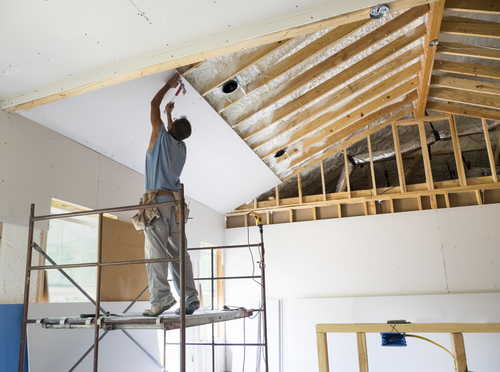Best ceiling & drywall specialists in Cosmo City, Gauteng
Top ceiling & drywall specialists near you
Browse the best ceiling & drywall experts and compare ratings and reviews.
Hire the best ceiling & drywall specialist
Search Uptasker for the best ceiling & drywall specialists
How can a ceiling and drywall specialist be of help to me?
The structures we build are all aimed primarily at providing a dry, climatically pleasant and secure environment within which to live and work. The external facing of the building - the bricks and mortar, so to speak - provides the main structural strength and shape, but there is more leeway in the interior of the construction to allow for aesthetic design and functionality. We can probably all remember older homes which had ornate ceiling designs which became highly prized features in later years. In modern buildings, there is often a need for ceilings which house several different applications, such as insulation, lighting, design features, sound or intercom systems, which is often done through the use of bulkhead ceilings. Large, open spaces are often divided into smaller rooms through the erection of semi-permanent walls which serve their purpose perfectly well without being difficult to remove if the layout has to be altered to suit ongoing needs. These are the areas where a ceiling and drywall specialist excels.
What are the different types of ceiling available?
There are a number of options available when it comes to the construction of a ceiling, many of which depend on the prime function of a ceiling in any given area. Some of these are :
- A bulkhead is a specific section of ceiling that has been lowered and boxed-in or enclosed, most often to house special lighting features or built-in speakers and sound systems;
- Dropped or suspended ceilings, which are extremely functional false ceilings which create a space between the original ceiling or roof and the floor below. These ceilings are often found in factory premises, hospitals and restaurants, where they cover certain building infrastructures such as piping, wiring and ducting, whilst allowing easy access for repairs and inspections. These ceilings may also serve to hide other problems, such as structural damage or unsightly imperfections on the original ceilings. These ceilings may also be used to cover beam ceilings which may have been part of the original design of the house, such as with thatched roofs or in large houses with double-storey ceiling heights. Whilst these features are extremely attractive and give a great sense of space, they are problematic when it comes to heating the space in winter;
- Tray ceilings, which are built to resemble an inverted tray with a number of stepped levels, the highest of which is at the centre of the ceiling. This type of ceiling serves to make a small room look taller;
- Shed ceilings, usually used in attic rooms with varying wall heights within the room. These ceilings are characterized by an upward slope on one side. If constructed thoughtfully and with maximum use of the space available, this type of ceiling can make a small attic room extremely functional and attractive.
Any of the above ceilings can be created using drywall materials.
Why do we use drywalling?
Drywalling is used for a number of reasons in the construction of both interior walls and ceilings. It has the advantage of providing existing walls with a smooth, flat finish, as joins can easily be plastered (this is then termed ‘plasterboard’) and painted to form a continuous even finish. It is both cost effective and quick to install in almost any space, and provides a barrier between interior areas and outside vermin, dust, insects and air, making it a highly practicable insulation material. It lends itself to many design features such as arches, eaves and specifically designed architectural features. As such, it allows for a great deal of design freedom, such as ‘false’ walling which allows for niches and ‘built-in’ shelving on an otherwise flat wall. Drywall itself is not particularly strong and can therefore easily be damaged by hard knocks, but has the advantage of being easy to repair as the damaged area can easily be cut away and replaced. Drywall was originally invented in The USA in 1916 by the U S Gypsum Company, so it has been in use for many years. Drywall’s gypsum content is itself not flammable, and it is therefore extremely useful as it provides natural fire resistance. Drywall does, however, need to be painted and cannot be left in its original state, as it is susceptible to moisture and must therefore be sealed against mould or water damage if exposed to high levels of moisture over extended periods of time. More information on gyprock specialists may be found in our blog section.
How to find the right ceiling and drywall specialist for your needs
Check their online ratings and customer reviews
The internet is steadily becoming one of the advertising forums for ceiling and drywall specialists. If they have dedicated websites, it is easy for these specialists to showcase their work for previous customers, which is extremely useful during internet searches. Search sites such as Uptasker are great time-saving resources, particularly as Uptasker lists online ratings and customer reviews which make it faster to judge service and quality satisfaction levels from other customers. Since it lists suppliers geographically, Uptasker saves additional search time and allows you to request and compare quotes from various suppliers based on the same specifications. You can also check for advertisements in building, house and home magazines and catalogues, visit home expos, speak to architects and building contractors, or check the Yellow Pages and newspapers for these specialists. If you are lucky enough to have friends or colleagues in your area who have had work done by one of these experts and are impressed with the reviews and finished product, by all means source your supplier this way.
Top ceiling and drywall specialist tips

You really don’t have to live with unsightly, uneven or cracked walls, or battle to try to create workable offices in premises with a layout which simply does not work for your business. Neither do you have to live with ceilings which do not suit your home, office, factory, commercial or restaurant premises, look unattractive or are simply unsuitable for their purpose. Many options exist to create an inviting, comfortable and useful environment, and these choices are mainly available through the expertise of ceiling and drywall specialists. Even if you have no ideas on how to improve your space, you can rely on these experts to find a solution. For more tips, see our ceiling and drywall specialist articles.
Read Ceiling & Drywall articles



